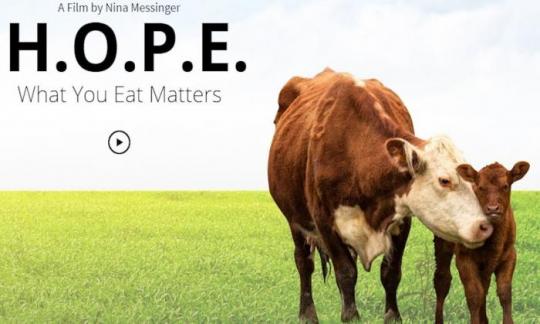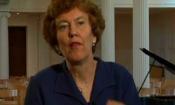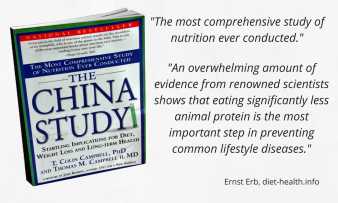Hope for all — movie overview
Hope for all is a powerful and touching movie that brings the world’s health status to the forefront and focuses on the problems a meat-based diet causes for people, animals, and the planet.
Heart disease, cancer, diabetes, and obesity — these are only a few of the conditions associated with the Western diet and their incidence has been skyrocketing over the last few decades.
Never before have we been so well informed about nutrition … in theory. In practice, in everyday life, we succumb to mindless cravings, devour instant meals, gobble cafeteria fare, and stuff our faces into fast food […].
02:16: Cardiovascular diseases are the main cause of death, the number of cancer cases is rising dramatically, diabetes has become an epidemic, and one in two Americans and Europeans are overweight. These facts depict the dire health state of our world today. According to numerous scientists and health practitioners, this dramatic situation is rooted in an unhealthy lifestyle and a reliance on a diet based on animal products.
According to Dr. Rüdiger Dahlke, an Austrian physician and psychotherapist, it was only affluent people who could afford to eat meat in the past. Now, this is possible for almost everyone who lives in a developed country. However, as Dr. Dhlke expresses it, Financially we can afford it. Healthwise, we can’t do that. The main reasons why people eat meat remain low price, tradition, and taste.
This is also supported by Sharon Kintz’s testimonial, in which she talks about her SAD diet (Standard American Diet), which was guided by taste and pleasure but led to a heart attack and open-heart surgery.
6:20: Dr. Cardwell Esselstyn, 82 years old, a renowned surgeon and researcher, coordinates the Cardiovascular Prevention and Reversal Program at the Cleveland Clinic Wellness Institute in Ohio. Based on years of research and practical experience, he questions the classical forms of treatment for heart diseases and considers that these therapies address only the symptoms and not the cause.
Even though people think that bad genes, age, or simply bad luck lie at the root of heart diseases, numerous scientific studies show that these conditions are actually caused by our dietary habits. According to Esselstyn, every time we eat certain foods, the capacity of endothelial cells is impaired. The role of the endothelial cells in the body is to produce nitric oxide, which protects the blood vessels, keeps the blood flowing smoothly, and prevents the artery walls from getting inflamed or thickening. Cardiovascular diseases start with the progressive damage of endothelial cells, which is caused by excessive consumption of animal and processed foods.
A strong supporter of a low-fat, plant-based diet, Dr. Esselstyn believes that this type of nutrition not only prevents cardiac diseases but also reverses their effects.
Sharon Kintz’s testimonial complements Esselstyn’s point of view. After two years following Dr. Esselstyn’s program, she significantly improved her health and fitness level.
11:40: This section addresses the overconsumption of milk and its increased availability. The high amounts of saturated fat, cholesterol, and animal protein in milk as well as lactose (which can’t be digested by lactose-intolerant people) are the cause for multiple health issues.
To support these affirmations, Dr. T. Colin Campbell presents a series of studies showing that casein (the main protein found in milk) is the strongest promoter of cancer.
In one experiment, scientists fed rats carcinogenic substances. Afterward, half of the mice received a diet with 5% casein, and the other half a diet with 20% casein (the typical amount consumed in western diets). The first group didn’t develop cancer, but the second one did. However, after switching to a 5% casein diet, cancer "growing" ceased. Studies with humans also support these findings.
14:55: Prof. Dr. Claus Leitzmann, a German nutritionist and biochemist, discusses the calcium problem. Numerous people consider milk and dairy products as essential sources of calcium. However, tests conducted on people who consume no milk or dairy products show that osteoporosis incidence is lower in their case. Dr. Campbell also mentions the allergenic properties of dairy, stressing that milk can either cause allergies or enhance allergies coming from other sources. Moreover, symptoms such as acne, migraines, and headaches disappear immediately as soon as people stop consuming dairy products.
16:59: Prof. Dr. Thomas Wendt, a German cardiologist, talks about his father Lothar Wendt, who introduced the concept of protein storage diseases in 1949. Novel at that time, the idea that too much protein in one’s diet causes illnesses was only scientifically shown in the last few decades and also supported by Dr. Campbell’s renowned China Study.
18:56: In a detailed testimonial, Arthur Soteros, an American and former cardiac patient, talks about his health issues and healing journey. Starting at the age of 32 with type 2 diabetes, he then developed severe heart disease at 42 and went through a coronary bypass and multiple stents (tiny tubes placed inside the blood vessels to keep them open). After changing his eating habits, he no longer suffered from angina or diabetes. With improved eyesight and a healthy weight, he happily declares, I feel better now at age 53 than I feel at age 30.
Ralf Brosius, once diagnosed with final-stage lung cancer and metastases in lymph nodes, reports a similar recovery. As does Dr. Campbell’s wife, who was at one point diagnosed with stage-three melanoma (a severe form of cancer).
These testimonials once again show that a plant-based diet can provide the human body with all of the nutrients needed for a healthy and active life: dietary fiber, phytonutrients, enough protein, healthy fats, complex carbohydrates, antioxidants, vitamins, trace elements, and enzymes.
25:50: Dr. Ernst Walter Henrich, a Swiss physician and nutrition expert, comments that it is precisely the products that harm our health that is a significant source of revenue for their producers. Moreover, the pharma and health industry is making a profit based on people’s illnesses, and they, therefore, have no interest in changing the situation.
There are no other interest groups on whose agenda is to keep people healthy. Who is financially interested in keeping people healthy?
Additionally, Dr. Henrich points out that supporters of the meat, dairy, and egg industry have infiltrated the academic community and the government, and are thus capable of influencing decisions on a large scale.
In an attempt to have physicians and medical practitioners take responsibility and encourage them to include dietary advice in their treatment plans, Dr. Esselstyn states: The scientific revolution in health is never going to occur from inventing another pill or drug, and it is not going to come from inventing another procedure or operation. The revolution in health can come when those of us in the healing profession are able to share with the public what type of lifestyle protects them from this chronic, killing disease.
29:55: The second main part of the movie starts with this powerful quote from Mahatma Gandhi: Earth provides enough to satisfy every man’s need but not every man’s greed. The following sequences depict the harmful impact meat consumption has on the environment and the planet.
Karl Ludwig Schweisfurth, who worked for one of Europe’s largest meat producers, states that increasing meat production to meet the demand of a rising population is not possible nor sustainable. Sociologists expect that the world population will reach 9 billion by 2025. This would require that we almost double the livestock, which in turn would require additional land for pastures and intensive farms. According to the Global Agricultural Report, our current form of agriculture is practically destroying our means of subsistence.
Dr. Vandana Shiva, an Indian physicist, and Alternative Nobel laureate point out that most of the grain grown on our planet is not used as food for human beings. Instead, it is fed to animals. We are talking about a system that is creating hunger on the planet, in the name of feeding people. Since industrialized nations can no longer produce the amount of grain necessary to support the internal demand for cattle feed, they end up importing ¾ of it from South America, contributing further to deforestation and land degradation.
34:18: Dr. Jane Goodall, a British primatologist and U.N. messenger for peace, talks about the shocking effect deforestation has on the environment. With 20% of the Amazon forests destroyed forever, our planet has lost immense reservoirs of CO2, which could have stabilized the climate.
Martin Hofstetter, a German agricultural expert for Greenpeace, presents an analogy between meat consumption and the distance driven with a personal car in terms of CO2 exhaust:
| Meat | CO2 | Distance Driven with a Personal Car |
| 1 kg beef | 12–13 kg | 100 km |
| 1 kg pork or poultry | 6 kg | 50 km |
| Vegetables | 600 g | A few km |
The conclusion — To help the climate, we should, of course, drive less, but we should also eat less meat.
Other problems caused by excessive meat production are related to methane gas production (25 more detrimental to the climate than CO2), the release of nitrous oxide from synthetic fertilizers (300 times more harmful to the environment than CO2), and the ammonia and nitrates released by animal excrement (polluting the soil and the drinking water).
The situation is even more alarming when it comes to the water needed to produce meat and cheese:
| 1 kg of product | Amount of Water Necessary for the Production |
| Eggs | 3'300 L |
| Chicken | 3'900 L |
| Pork | 4'800 L |
| Cheese | 5'000 L |
| Beef | 15'500 L |
| Grain | 1'300 L |
| Potatoes | 900 L |
| Apples | 700 L |
Dr. Vandana Shiva concludes by saying, This is a recipe for biological disaster, biodiversity disaster, water disaster, climate disaster, and health disaster.
44:20: The third main section of the documentary shows the reality of intensive animal farming and presents powerful testimonials from former employees in this industry.
Josef Walchshofer, a former Austrian butcher, and Dr. Hermann Focke, a former German veterinary director, point out the long-lost relationship between people and animals and how the animals have been transformed into a commodity.
Since 98% of meat comes from factory farms, meat producers have to meet record deadlines in terms of raising and slaughtering animals. The increased demand for milk has led producers to develop more means to force cows to achieve higher outputs (from an annual average of 1'500 L of milk per cow in the 1960s to the current annual average of over 10'000 L).
53:20: Jan Gerdes, a former German dairy farmer, discusses the problems raised by automation and the fact that since cows are milked by robots and animals are fed by machines that nobody notices when the animals are sick. This leads to one of the most major problems in factory farming — the spreading of infections, which is worsened by crowded conditions, overbreeding, and lack of hygiene. The industry’s answer to this situation (medicine and antibiotics) creates even more problems for animals and people (over 700'000 people have died as a result of infections caused by resistant bacteria). With up to three-fourths of all antibiotics ending up in factory farms, it can be concluded that the system in itself is entirely sick.
Prof. Dr. Marc Bekoff, an American animal behaviorist, talks about animal abuse throughout various institutions such as education, research, circuses, rodeos, and zoos. However, none of these reach the level of mistreatment that takes place in factory farming.
58:10: Harold Brown, a former American cattle and dairy farmer challenges the false idea that dairy products are benign and that there is no harm in drinking milk. What many people don’t realize is that cows produce milk only after they gave birth. Within 24–72 hours of birth, the calf is taken away and the milk is used for dairy production. The cows are left to mourn their lost children for days.
When we eat meat and dairy products, we are basically paying people to impregnate animals, steal their babies, steal their milk, and then kill them.
Benjamin Zephaniah, a British poet, writer, and musician, challenges people to think how this would feel if somebody would do that to the human species.
Moreover, animal behaviorists have already shown that animals have emotional lives. Despite common opinion, cows have social structures and habits that resemble human ones (e.g., they build community, babysit for each other, and mourn the loss of loved ones).
Animal behaviorists believe that a change in discourse from “what we eat” to “who we eat,” is essential: They are not ‘what’ we eat, but ‘who’ we eat. If there is an animal on the plate or at the end of the fork, it is who’s for dinner, not what’s for dinner.
1:10: Hubert Liebertz, a former German butcher, talks about the violent means used by farmers to persuade animals to go to slaughter. Despite the fact that everyone is aware that animals have to die so that we can eat meat, few people are aware of what happens in slaughterhouses (an experience that is difficult for slaughterhouse workers as well).
Electrocution, gas chambers, and CO2 stunning are the most commonly used means to kill animals in large meat factories.
However, Prof. Dr. Klaus Tröger, a former German director of the Department of Safety and Quality of Meat, reveals the shortcomings of these methods: even though it is considered to be the cheapest method, CO2 stunning causes animals to experience suffocation for 15–20 seconds. Their throats have to be cut very quickly; otherwise, they become conscious when immersed in boiling water. Nevertheless, due to time pressure (workers have to stick 750 pigs/hour, meaning 5 seconds per pig) and human error (sometimes the main artery isn’t correctly severed), in more than 12% of cases, pigs are left alive for the following procedures.
Animals from organic farms go through the same ordeal.
Chickens are processed fully automatic and at high speed. In an hour, 10'000 animals are stunned, killed, cleaned, and cut into parts in a modern slaughterhouse (the largest slaughterhouse in Germany processes 27'000 chickens per hour).
While being confined in a stunning trap, cattle are shot with a captive bolt gun, a procedure that in over 9% of the cases doesn’t succeed, leaving cattle conscious and suffering throughout the entire slaughtering process.
Why must humanity, the consumer, be shielded from the slaughterhouses? If this were right, then why? Cheese dairies don’t make you look away. Demonstration bakeries are common today too. But there is no single demonstration slaughterhouse in the country because it is so brutal. Because it is plain violence.
1:20: Introducing the concept of carnism, Dr. Melanie Joy, an American social psychologist, points out the contradiction in how people treat animals: some of them are loved and treated as family members while others are objectified and seen as abstractions that lack individuality and personality. The concept of carnism basically depicts a belief system intended to prevent us from recognizing the violence and cruelty of the system behind eating animals.
1:25: Dr. Jane Goodall talks about making conscious decisions regarding food. Along these lines, Prof. Claus Leitzmann stresses the importance of adults as role models for children and other community members.
Everyone can make a difference. Every one of us eats at least 2–3 times a day. And every act of conscious eating of knowing what the consequences of your eating are, knowing what you are eating, is an act of changing the world. Dr. Vandana Shiva
More videos
To understand health and ecology, extensive basic knowledge is required. Here you will find fact-based texts and book reviews.
Due to a lack of knowledge, vegetarians, vegans, and raw foodists often eat unhealthily – for years or even decades. This basic knowledge can prevent this.
The China Study clearly lays out how the current Western diet can be improved to prevent lifestyle diseases. We say: Most important book on nutrition and health
Erb Muesli with Rolled Oats is a vegan (lactose-free), raw muesli. It serves as an especially healthy breakfast and is a good “bread replacement.”
These Cucumber Rolls with “Goat’s Cheese” and Mint Sauce hold together surprisingly well. They are ideal as an appetizer or finger food.
Sun-dried chili peppers and parsley give the savory pea pancakes a special flair. We recommend trying the pancakes with curry.











